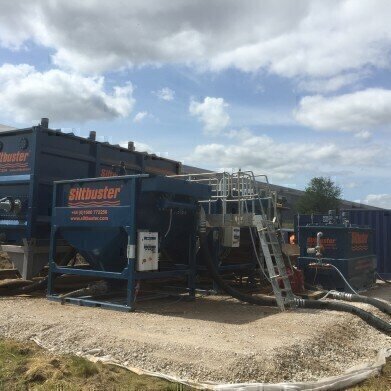-
 Siltbuster equipment used on the Western Link project
Siltbuster equipment used on the Western Link project
Water/Wastewater
Groundwater Problem Tackled as part of £1bn Renewable Energy Project
Nov 09 2016
Siltbuster (UK) has created and installed a processing plant in just seven days to help remove dissolved iron from groundwater as part of the £1 billion project commissioned by National Grid and Scottish Power Transmission. The project to build the Western Link is bringing renewable energy from Scotland to homes and businesses in England and Wales and is being delivered by a Consortium of Prysmian Group (responsible for cable manufacture and installation) and Siemens (responsible for converter stations).
The dissolved, iron contamination arose when below ground, high voltage, power cables were being installed. The complex cable routes, spanning a distance of 420 Km, pass within TATA Steel’s works at Shotton. When installing the 400kV A.C cables on this land it was found that the groundwater generated was in parts heavily contaminated with dissolved iron. Such contaminated water would pose significant risk to aquatic life if discharged without treatment.
Removing the groundwater was important as the cables were being installed using open cut trench method with well pointing used to dewater the trenches and joint bays; this all had to remain dry 24 hours a day during the cable installation and jointing works.
Tankering the groundwater offsite for treatment would have required an articulated tanker (50m3) every hour, 24 hours a day, at huge costs both financially (cost £150-£250 per cubic meter) and to the environment, in terms of carbon footprint.
So the Consortium’s subcontractor Balfour Beatty’s environmental team contacted Siltbuster to explore the best way to deal with the iron contaminated water. Siltbuster’s experts got to work designing the best practical solution. The system had to be robust, cope with the flow rates of between 15 and 50 m3/hr, ensure compliance by reducing the iron concentration within the water to below 10 mg/l and be easy enough for site personnel to operate.
After analysing the groundwater samples from the site, the Siltbuster team devised and commissioned a metals removal system within 7 days. The miniature industrial processing plant comprises a multi-stage reaction tank where Sodium Hydroxide increases the pH of the influent. In addition, compressed air is introduced to the reaction chamber to aerate the water, to allow the ferrous iron to oxidise to the insoluble ferric state. In the final stage of the process, flocculant is added to improve the settling characteristics of the solids including the newly formed iron hydroxide.
Separation of the precipitated solids occurs as the water passes under gravity through two of Siltbuster’s HB40R lamella clarifiers. Each of the clarifiers is fitted with a sludge pump to transfer the arising slurry from the hoppers to the sludge holding tank where the slurry is stored and conditioned prior to the dewatering process. To further reduce disposal costs, a 280L filter press dewaters the slurry to form a filter cake. The cake is captured in a conventional builder’s skip and removed from site to appropriately accredited landfill.
The easy to operate system performed well. Laboratory results show it reduces the iron concentration within the water from 159 mg/l to on average 0.6 mg/l, well below the target level of 10 mg/l as set out in the environmental permits.
Events
Apr 22 2024 Hannover, Germany
Apr 23 2024 Kuala Lumpur, Malaysia
Apr 24 2024 Sao Paulo, Brasil
May 05 2024 Seville, Spain
May 13 2024 Munich, Germany












